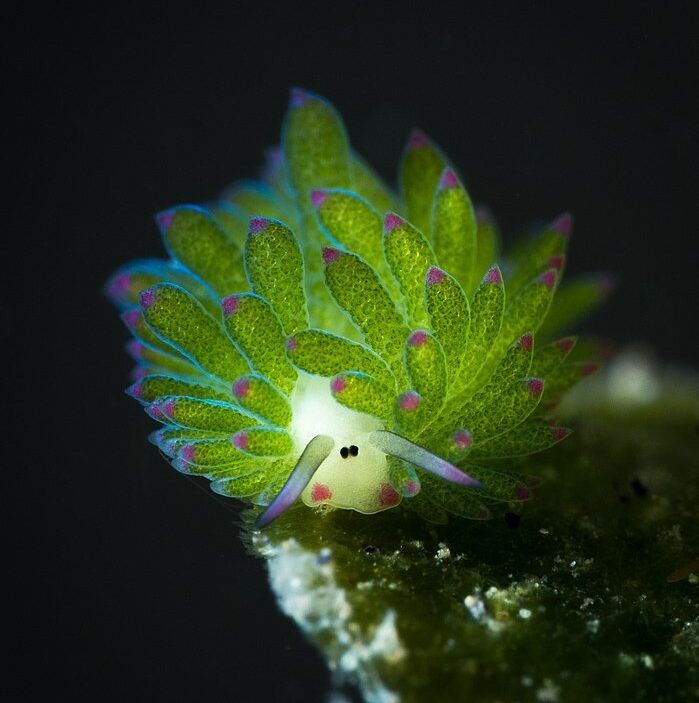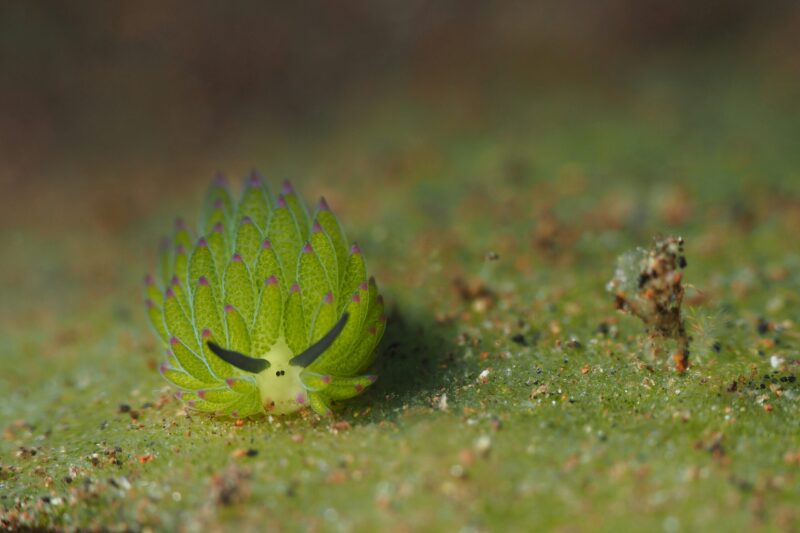Leaf sheep sea slug
This little critter looks like a sheep with its white face, black eyes and bushy body. But it doesn’t produce wool or milk. And it’s not even a real sheep. This is a leaf sheep sea slug. So it’s a type of gastropod mollusk that scientists call Costasiella kuroshimae.

An adorable appearance
Unlike land slugs, sea slugs can be much more colorful and flamboyantly adorned. Sea slugs can be blue, yellow, green, red, purple, white or brown.
Those elongated protrusions near the leaf sheep’s face are not ears. They’re called rhinophores. These are sensory organs of mollusks that serve as chemical sensors. Rhinophores are rod-shaped, as seen in snails, and are the most prominent part of their body. These small organs also have fine hairs that help them detect chemical compounds in the water to find sources of food.
These tiny creatures measure just 0.15 to 0.40 inches (4 to 10 millimeters).

Feeding habits of the leaf sheep
This animal is one of the few that can perform photosynthesis. But they do it in an unusual way. Leaf sheep feed on algae, and in doing so, they also absorb algae’s chloroplasts. Then they use those chloroplasts to photosynthesize energy from light into food.
The bushy, leaflike appendages all over their body contain the chloroplasts. Additionally, chloroplasts contain chlorophyll, so besides enabling photosynthesis, they also color this animal green. Thus, the body of this small creature looks like a coat of green leaves.
Algae and leaf sheep have a symbiotic relationship, meaning an association between organisms of different species. In most cases, both species help each other, but sometimes one takes advantage of the other. The process in which leaf sheep obtain chloroplasts from algae is known as kleptoplasty, which comes from the Greek root word for “thief.” And it enables leaf sheep to acquire plant-like functions such as photosynthesis.
Sea slugs can feed on algae and also use the sugars produced by chloroplasts, giving them a useful alternative food source. So, although leaf sheep can feed on their own, photosynthesis provides them with extra fuel. If algae are scarce, leaf sheep could survive for a time thanks to chloroplasts producing sugars.

Fun facts about leaf sheep
I never get tired of reading and seeing pictures of these incredible creatures, do you? Here are some other interesting facts. Leaf sheep are bioluminescent due to the absorption of chloroplasts.

These slugs are hermaphroditic organisms, meaning they are both female and male. Also, leaf sheep can lay between 2,000 and 4,000 eggs. The eggs hatch in four days.
Leaf sheep live wherever their favorite food is found. The algae they eat (genus Vaucheria) grow in Japan, Indonesia and the Philippines. They live in intertidal zones, that is, areas covered during high tides and visible during low tides. So, it could be said that leaf sheep can come out of the water.
The leaf sheep’s scientific name is a combination of Latin and Japanese. Costasiella indicates the genus name and kuroshimae comes from the Japanese island of Kuroshima, located off the coast of Taiwan. It was in these clear waters that the leaf sheep was first discovered in 1993.
Bottom line: These sheep don’t bleat or produce wool or milk. Instead, they live in the water and perform photosynthesis. Find out more about the adorable leaf sheep sea slug.
Sea turtles are as old as dinosaurs: Lifeform of the week
Seahorses are tiny, ravenous creatures: Lifeform of the week











